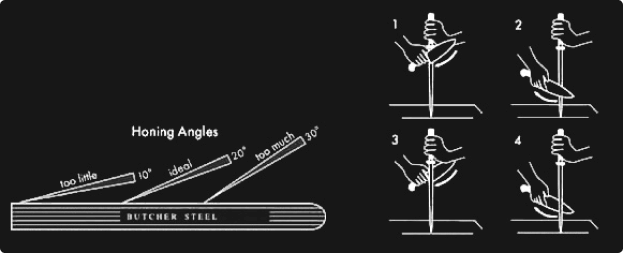

-
Guiding Tips for Your New Cutlery Care
for a Lifetime of Precision and Performance Crafted for a lifetime
-
Our knives are easy to care for. A few tips & and tricks ensure they stay razor-sharp."
- Hand wash your knife immediately after use and ensure thorough drying.
- Avoid using a dishwasher to prevent potential damage to high-carbon steel and handles.
- Never leave the knife submerged in water for an extended period.
- Sharpen the blade as needed using a quality sharpening rod (diamond or ceramic), whetstone, or similar tool.
How to Clean Your Knives?
How to sharpen your knives?
- Gather a sharpening stone or a user-friendly knife sharpener.
- Inspect your knife for any damage or irregularities. Wipe it clean with a damp cloth.
- Maintain a consistent angle, around 15-20 degrees, while sharpening. This ensures a proper edge.
- If using a sharpening stone, start with the coarse side, then move to the fine side. For electric sharpeners, follow the device's instructions.
- Safely test the sharpness by making a few cuts. Once satisfied, store your newly sharpened knife in a secure place.

What Is the Ideal Knife Sharpness?
Knife Sharpness and Blade Angle:
Generally, the sharpness of a knife is influenced by the angle of the blade. A more acute angle results in a sharper blade. The ideal degree for a knife typically falls between 15 and 30 degrees.
Regional Sharpening Practices:
Eastern knives are commonly sharpened to
15 degrees, while Western knives are typically sharpened to 20 degrees.
Specific Edge Degrees:
Executive Chef Series: 20-22 degrees on each side
What Is the Ideal Knife Sharpness?

Knife Sharpness and Blade Angle:
Generally, the sharpness of a knife is influenced by the angle of the blade. A more acute angle results in a sharper blade. The ideal degree for a knife typically falls between 15 and 30 degrees.
Regional Sharpening Practices:
Eastern knives are commonly sharpened to
15 degrees, while Western knives are typically sharpened to 20 degrees.
Specific Edge Degrees:
Executive Chef Series: 20-22 degrees on each side
Knife Usage and Storage Tips
Keep your chopping boards clean by washing them frequently with detergent. Ensure they are free of deep scratches, providing a hygienic surface for food preparation.
Use wooden or plastic boards to keep knives sharp, avoiding glass or metal surfaces. Opt for these materials for blade gentleness and maintain sanitation with regular washing.
Refrain from using knives on bones, joints, or frozen foods, as they are designed for precision slicing, not crushing through hard materials.
When cutting, avoid twisting the blade, as this can cause damage. Instead, use controlled, straight motions for efficient and safe cutting.
Store Knives Correctly
Store the knife in its designated spot, whether in a knife block or sheath, to maintain its pristine condition for future use.
Plastic Sheaths:
Use sheaths to protect blades and safely store knives in drawers, preventing damage and accidental cuts
Drawer Insert:
Keep knives organized in drawers with inserts, saving counter space and ensuring easy access.
Knife Block:
If space allows, opt for a knife block for a classic, easily accessible storage solution.



























